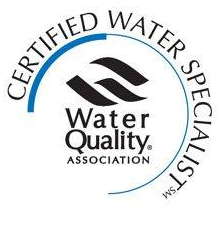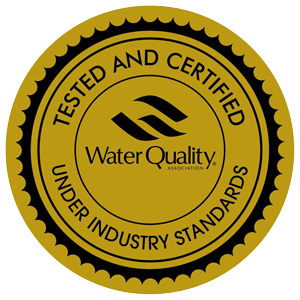Home |
Residential |
Iron, Hydrogen Sulfide, Manganese, Radium, Arsenic, Color & Odor Removal Filtration System |
Iron, Hydrogen Sulfide, Manganese, Radium, Arsenic, Color & Odor Removal Filtration Systems


The dark colored stains on sinks, toilets and showers, strong metallic taste, rotten egg smell and impossible laundry are clear signs that you have iron, Hydrogen Sulfide or manganese in your water.
These culprits take on different forms and must be properly identified in order to choose the proper system for effective removal.
2510SXT Air Charger Sulfur & Iron Removal Filters For Well Water
Removes Iron & hydrogen sulfide Gas
No chemicals required. Natural air injection
Crystal clear, non-staining water
How does it work?
When the sulfur air charger filter backwashes each night, air is drawn into the iron filter, creating a pocket of air at the top of the tank. As water enters the filter tank it passes through a layer of air.
Special filter media included Centaur Catalytic Carbon and KDF remove all traces of the hydrogen sulfide gas and odors. The result is clear, clean, fresh-smelling water through out the home!
During the backwash, accumulated sediment is flushed out to drain. The media stays clean and pressure is restored. Backwash each night (or every 2 nights) for best results, as backwashing keeps fresh air in the tank.


Air Charger Iron Filter 2510-SXT
A single tank system is an efficient and cost effective system for the removal of iron.
This type of Iron filter maintains an “air pocket” in the top of the tank while the system is in service. As the water passes thru the air pocket, iron oxidized. Additionally, dissolved oxygen is added to the water. The iron filter media bed then removes the iron and from the water.
Iron filter systems come equipped with a Fleck 2510SXT air injection control head that automatically backwashes the system daily to clean the media and flush everything down the drain. By utilizing a patented piston in the control valve, the iron filter is able to put the whole oxidation process inside one tank, keeping maintenance costs and downtime to a minimum.
Air Charger Sulfur Filter 2510-SXT
A single tank system is an efficient and cost effective system for the removal of sulfur.
This type of Sulfur filter maintains an “air pocket” in the top of the tank while the system is in service. Dissolved oxygen is added to the water.
Air charge sulfur filters can generally remove up to 8 ppm Hydrogen Sulfide. A daily backwash will remove accumulated Sulfur and replenish the filter media bed. The regeneration process also adds a fresh air pocket to the system.
Sulfur filter systems come equipped with a Fleck 2510SXT air injection control head that automatically backwashes the system daily to clean the media and flush everything down the drain. By utilizing a patented piston in the control valve, the iron filter is able to put the whole oxidation process inside one tank, keeping maintenance costs and downtime to a minimum.
Benefits
- Clean & clear water
- Brighter & cleaner laundry
- No more scale builds up & brown staining
- No more rotten egg smell & odor
- Less detergent usages.



Brim, Green Sand, KDF, Granular Activated Catalyst Cabon Filtration Systems
Brim is an efficient and economical media for the reduction of dissolved iron and manganese compounds from raw water supplies. It may be used in either gravity fed or pressurized water treatment systems.
Birm acts as an insoluble catalyst to enhance the reaction between dissolved oxygen (D.O.) and the iron compounds. In ground water, the dissolved iron is usually in the ferrous bicarbonate state due to the excess of free carbon dioxide and is not filterable. Birm, acting as a catalyst between the oxygen and the soluble iron compounds, enhances the oxidation reaction of iron and produces ferric hydroxide which makes the iron combine into sediment particles and may be easily filtered.
The physical characteristics of Birm provide an excellent filter media which is easily cleaned by backwashing to remove the precipitant. Birm is not consumed in the iron removal operation and, therefore, offers a tremendous economic advantage over other iron removal methods.
If the influent water has a pH of less that 6.8, neutralizing additives such as Clack Corosex®, Calcite or soda ash may be used prior to the Birm filter to raise the pH. A water having a low D.O. level may be pretreated by aeration.
Additions of chemicals to influent or backwash water which contacts Birm media may inhibit iron or manganese removal or may break down or coat Birm media. Chlorination greatly reduces Birm’s activity. High concentrations of chlorine compounds may deplete the catalytic coating.
Polyphosphates are known to coat Birm and reduce Birm’s ability to remove iron or manganese. Before adding any chemical to the influent or backwash water, the chemical's compatibility with Birm should be thoroughly tested.
Birm may also be used for manganese reduction with the same dependability as iron removal. In these applications, the water to be treated should have a pH of 8.0-9.0 for best results. If the water also contains iron, the pH should be below 8.5. High pH conditions may cause the formulation of colloidal iron which is very difficult to filter out. All other conditions remain the same for either manganese or iron removal.
Benefits
- Long material life with relatively low attrition loss
- A wide temperature performance range and extremely high removal efficiency.
- Negligible labor costs are involved because Birm does not require chemicals for regeneration, only periodic backwashing is required.
When using Birm for iron removal, it is necessary that the water: - Contain no oil or hydrogen sulfide
- Organic matter not to exceed 4-5 ppm
- The Dissolved Oxygen content equal at least 15% of the Iron content
- A pH of 6.8 or more.
Manganese Green Sand
The Manganese Greensand process for the removal of iron, manganese and hydrogen sulfide from groundwaters has been used since the 1950's in the United States. Today there are two distinct treatment processes associated with the use of manganese greensand; specifically, the "IR" (intermittent regeneration) and the "CR" (continuous regeneration), both of which have become industry standards. In addition, manganese greensand can, under certain conditions, remove manganese by catalytic oxidation.
Manganese Greensand is processed from what is commonly known as New Jersey greensand but more correctly identified as glauconite, an iron, potassium, alumino-silicate material of marine origin. Glauconite occurs along the eastern coast of the United States where it was deposited approximately 75- 80 million years ago during the geologic time known as the Cretaceous period. Greensand has been used since the 1920's originally as a natural zeolite for water softening due to its relatively high ion exchange capacity of approximately 3,000 grains/cu. ft. Until the development of synthetic gel- type ion exchange resins following World War II, which had a capacity of about six to seven times that of glauconite, the greensand zeolites were an efficient and reliable part of the softening industry.
For iron and manganese removal the naturally occurring singular nodular grains of glauconite are washed and classified to produce a filtration media having a sieve analysis of 18 x 60 mesh with a resulting effective size of 0.3-0.35 mm and a uniformity coefficient of 1.60 or less, giving the media excellent filtration characteristics. The glauconite is stabilized, then coated with manganese oxide in various valence states. It is this coating that provides the glauconite with its special chemical oxidation-reduction properties for the removal of iron and manganese as well as small quantities of hydrogen sulfide.
The advantages of the manganese greensand process over aeration and filtration are single pumping (as the process generally employs pressure filtration), reliability, flexibility, and a high quality effluent coupled with ease of operation. Both the CR and IR processes are relatively uncomplicated in both their design and operation and result in an efficient, reliable method for iron and manganese removal.
The mechanism for iron and manganese removal by manganese greensand in the CR method is oxidation followed by physical removal of the resulting precipitates by filtration using a manganese greensand or manganese greensand-anthracite bed. In the IR method, the manganese is removed by contact oxidation. Generally, the CR method is used where iron predominates with only small amounts of manganese, while the IR or catalytic oxidation process is used for water where manganese removal, with or without the presence of iron, is required.
KDF Media
KDF 55 and KDF 85 Process Media can remove up to 99% of water-soluble lead, mercury, nickel, chromium, and other dissolved metals. All KDF Process Media forms are effective in controlling the buildup of bacteria, algae, fungi and scale, making them ideal for use in GAC beds, ion exchange resins, carbon block filters and inline carbon filters. Wherever our Media are used, they can eliminate the need for costly, and sometimes harmful, chemical treatments.
KDF 55 Medium Designed specifically for removing or reducing chlorine and water-soluble heavy metals. It controls scale, bacteria and algae, even in hot water. The process medium received NSF International Certification and is certified by NSF to NSF/ANSI Standard 42 – Drinking Water Treatment Units – Aesthetic Effects. This medium is also in compliance with California’s Health and Safety Code Section 166875 (or commonly known as AB1953) and Vermont Act 193.
KDF 85 Medium Removes or reduces iron and hydrogen sulfide from municipal or other water supplies. Also controls scale, bacteria and algae.
KDF-F (Fines) Designed to remove chlorine and control bacteria when incorporated into carbon blocks as well as into other matrix-type filters.
KDF-C (Coarse Mesh) Granules are used for removal or reduction of soluble heavy metals and chlorine. For use when less pressure drop is required.


KDF Process Media vs. Activated Carbon
|
|
KDF Media |
Activated Carbon |
|
Life |
More than 6 years* |
Only 6 to 12 months |
|
Bacteria and Algae |
Controls Both |
Permits Growth |
|
Disposal |
Recyclable |
Hazardous Waste |
|
Mechanism |
Oxidation/Reduction |
Adsorption |
|
Lb/cu ft |
171 |
35 |
|
Contaminants Eliminated |
Inorganic |
Organic |
|
|
||
KDF Process Media vs. Silver-Impregnated Carbon
|
|
KDF Media |
Silver-Impregnated |
|
Life |
More than 6 years* |
Only 6 to 12 months |
|
Bacteria and Algae |
Controls Both |
Permits Growth |
|
Disposal |
Recyclable |
Hazardous Waste |
|
Mechanism |
Oxidation/Reduction |
Adsorption |
|
Heavy Metals |
Yes |
No |
|
pH |
6.5 to 8.5 |
Sensitive |
|
Use |
POU/POE, Industrial, Commercial |
Home Water Filter Products |
|
US EPA Registration |
Not Required |
Required |
 |
 |
|
|
|
|
|
Download 2510 SXT Control Valve Brochure
Download Brim Brochure
Download Green Sand Brochure
Download KDF Process Media Brochure
Download Granular Activated Carbon Brochure

 (905) 607-5999
(905) 607-5999 





















